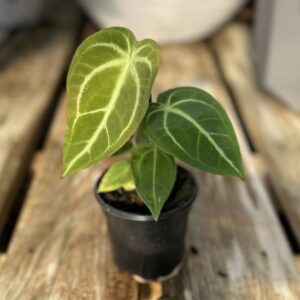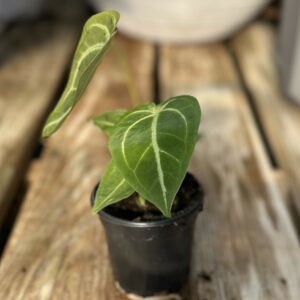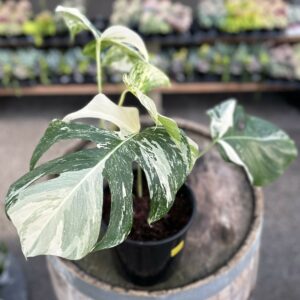-

$19.99
Alocasia ‘Frydek’ Care
Light: Alocasia ‘Frydek’ thrives in bright, indirect light. Avoid direct sunlight, which can scorch its leaves. Place it near a north or east-facing window where it receives filtered sunlight or provide artificial grow lights if natural light is insufficient.
Temperature: Maintain a warm and consistent temperature for your plant. Alocasia ‘Frydek’ prefers temperatures between 65°F to 80°F (18°C to 27°C). Avoid sudden temperature drops or drafts, as it’s sensitive to temperature fluctuations.
Humidity: This plant appreciates high humidity levels. To increase humidity, mist the plant regularly or use a humidity tray. Grouping it with other plants can also create a microclimate with higher humidity.
Watering: Keep the soil consistently moist during the growing season (spring and summer), but ensure it never sits in standing water. Water thoroughly and allow excess water to drain from the pot. Reduce watering in the dormant period (fall and winter) and let the top inch of soil dry out before watering again.
Soil: Use a well-draining potting mix with organic material, like peat moss, to retain moisture without becoming waterlogged. A mix designed for aroids or tropical plants is suitable.
Fertilization: Feed your Alocasia ‘Frydek’ every 4-6 weeks during the growing season with a balanced, water-soluble fertilizer diluted to half the recommended strength. Do not fertilize during the dormant period.
-


$34.99
Anthurium magnificum Care
Light: Provide bright, indirect light for your Anthurium magnificum. It appreciates filtered sunlight or dappled shade. Avoid exposing it to direct sunlight, as this can scorch the leaves.
Watering: Keep the soil consistently moist but not waterlogged. Water when the top inch of the soil feels slightly dry. Anthuriums do not like to dry out completely, so maintaining a consistent level of moisture is essential.
Humidity: Anthurium magnificum thrives in high humidity. Regular misting or placing the plant on a tray filled with water and pebbles can help create a more humid environment. Grouping plants together can also increase humidity levels.
Soil: Plant your Anthurium magnificum in a well-draining, peat-based potting mix. A mix formulated for orchids or aroids works well. Ensure the pot has drainage holes to prevent waterlogging.
Temperature: Maintain a warm environment for your Anthurium magnificum. It prefers temperatures between 65°F to 80°F (18°C to 27°C). Protect it from drafts and sudden temperature fluctuations.
Fertilization: Feed your Anthurium magnificum with a balanced liquid fertilizer every 4-6 weeks during the growing season (spring and summer). Reduce or eliminate fertilization in the fall and winter when the plant is not actively growing.
-


$269.99
Monstera borsigiana ‘Albo’ Care
Light: Provide bright, indirect sunlight for your Monstera borsigiana ‘Albo.’
Watering: Allow the top 1-2 inches of the soil to dry out before watering.
Humidity: Maintain higher humidity levels for your Monstera borsigiana ‘Albo.’
Temperature: Keep the plant in temperatures between 65-85°F (18-29°C).
Soil: Use a well-draining, aerated potting mix.
Fertilization: Feed your Monstera borsigiana ‘Albo’ with a balanced, diluted, water-soluble fertilizer during the growing season (spring and summer).
-


$12.99
Venus Fly Trap Care
Light: Venus Fly Traps need bright, direct sunlight to thrive. They should receive at least 4-6 hours of direct sunlight each day. Place them in a south-facing window or under artificial grow lights. Inadequate light can weaken the plant.
Water: Use distilled or rainwater to water your Venus Fly Trap. Avoid tap water or bottled water with added minerals, as these can harm the plant. Keep the soil consistently moist but not waterlogged. Always keep the saucer underneath the pot filled with water to maintain the required humidity.
Humidity: Venus Fly Traps require high humidity levels. You can increase humidity by placing the pot on a tray filled with water, using a humidity tray, or misting the plant regularly. Avoid letting the soil dry out.
Soil: Plant your Venus Fly Trap in a mixture of sphagnum moss and perlite. This soil combination provides the necessary acidity and moisture retention the plant needs.
Feeding: Venus Fly Traps obtain essential nutrients from the insects they capture. While it’s not required to feed them, if your plant doesn’t catch enough insects naturally, you can provide small insects, such as live flies or ants, to stimulate growth. Do not feed it human food or inorganic materials.
Triggers: Avoid touching the sensitive trigger hairs inside the traps. Repeatedly triggering the traps without prey can exhaust the plant’s energy.







